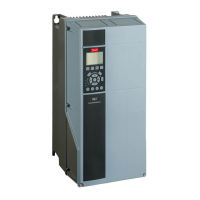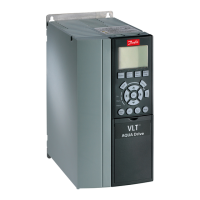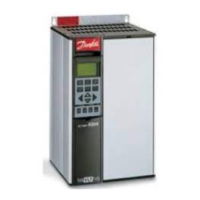9.6.1 Derating for Low-Speed Operation
When a motor is connected to a drive, it is necessary to check that the cooling of the motor is adequate. The level of
cooling required depends on the following:
•
Load on the motor.
•
Operating speed.
•
Length of operating time.
Constant torque applications
A problem can occur at low RPM values in constant torque applications. In a constant torque application, a motor can
overheat at low speeds because less cooling air is being provided by the fan within the motor.
If the motor is run continuously at an RPM value lower than half of the rated value, the motor must be supplied with extra
air cooling. If extra air cooling cannot be provided, a motor designed for low RPM/constant torque applications can be used
instead.
Variable (quadratic) torque applications
Extra cooling or derating of the motor is not required in variable torque applications where the torque is proportional to the
square of the speed, and the power is proportional to the cube of the speed. Centrifugal pumps and fans are common
variable torque applications.
9.6.2 Derating for Altitude
The cooling capability of air is decreased at lower air pressure. No derating is necessary at or below 1000 m (3281 ft). Above
1000 m (3281 ft), the ambient temperature (T
AMB
) or maximum output current (I
MAX
) should be derated. Refer to
Illustration 9.8.
Max.I
out
(%)
at T
AMB, MAX
Altitude (km)
HO
NO
T
at 100% I
out
100%
96%
92%
0 K
-3 K
-6 K
1 km 2 km 3 km
-5 K
-8 K
-11 K
130BT866.10
AMB, MAX
Illustration 9.8 Derating of Output Current Based on Altitude at T
AMB
,
MAX
Illustration 9.8 shows that at 41.7 °C (107 °F), 100% of the rated output current is available. At 45 °C (113 °F) (T
AMB
, MAX-3
K), 91% of the rated output current is available.
Mechanical Installation Con... Design Guide
MG16C302 Danfoss A/S © 11/2017 All rights reserved. 163
9 9

